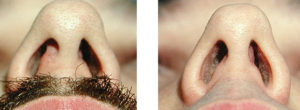The nasal septum is recognized by most people as an internal nasal structure that often is not straight and may lead to breathing problems. The nasal septum is the wall between the nostrils that separates the two nasal passages. It provides significant support to the dorsal line of the nose and directs airflow. The septum is made of thin bone in the back and cartilage in the front. A deviated septum occurs when the cartilage, bone, or both is not straight.

With deviated septums, there is another anatomic structure in the nose that usually also contributes to airflow obstruction. An enlarged inferior turbinate…a structure that projects from the lateral wall of the nose into the nasal cavity–may also be the cause. As the septum deviates the turbinate on the opposite side usually swells and fills what would otherwise be more open space. Therefore, many septal straightening procedures (septoplasty) are combined with turbinate reductions as part of functional nasal airway surgery. It is important that the turbinate not be removed completely as doing so may result in a very dry, crusty nose that is unable to adequately humidify and warm the air.
Often nasal breathing problems serve as an opportunity to have a cosmetic rhinoplasty as well. This is common (about half of my nose patients in my Indianapolis plastic surgery practice have airway surgery as well as cosmetic changes) and does represent a great opportunity to solve two concerns at once. Many patients think, incorrectly, that their health insurance will cover the rhinoplasty as well. This is inaccurate and actually to do so constitutes insurance fraud. Therefore, it is important that the patient understand their financial obligations for the rhinoplasty part and not see it as a free surgery that their insurance is going to cover.
Adding functional nasal airway surgery to a rhinoplasty adds one element to the recovery process. That of increased nasal congestion and stuffiness for several weeks after. It does not increase the amount of pain or bruising but one will have congestion and nasal drainage that otherwise would not be there in a cosmetic rhinoplasty alone.
Dr. Barry Eppley
Indianapolis, Indiana


